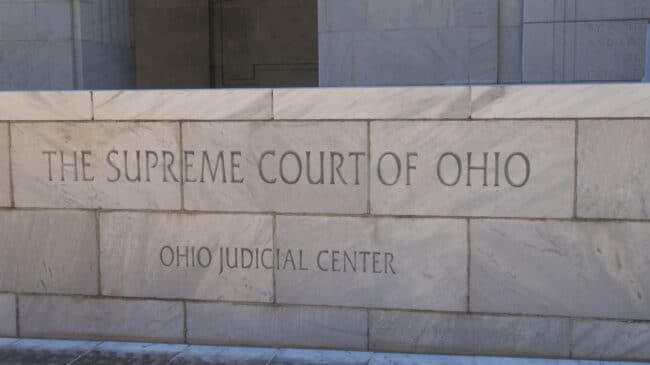Summary
Ohio’s Issue 1 on the November 2022 ballot requires a court to consider public safety concerns, such as the seriousness of the alleged offense, a person’s criminal record, and the likelihood a person will return to court when determining bail amount. The amendment would eliminate the Ohio Supreme Court’s current authority to determine the procedures for establishing the amount and conditions of bail.
Amendment 1 was advanced in response to an Ohio Supreme Court ruling, DuBose v. McGuffey. In that case, the state Supreme Court determined a $1.5 million bond for a Cincinnati man accused of fatally shooting a man during a robbery was too high. Through their ruling, the Ohio Supreme Court decided that only the defendant’s risk of non-appearance could be considered in determining bail amounts. This change in guidelines animated prosecutorial, judicial, and victim-rights interests to propose a constitutional change ensuring factors of public safety must once again be included in setting bail conditions.
Proponents’ Arguments
Those supporting the constitutional amendment believe courts should consider public safety, among other factors prescribed by the Ohio General Assembly, when determining bail amounts. They say these public safety factors include the seriousness of the individual’s alleged offense, the individual’s criminal history, and the likelihood of the individual reappearing in court for trial. Advocates believe Issue 1 will clearly and unambiguously guarantee courts include such factors in the financial conditions of bail.
Proponents of Issue 1 are concerned that career criminals may exploit the justice system’s presumption of innocence to commit additional crimes, if not disappear from law enforcement, before the adjudicating process. They further citte public safety as a historical and appropriate consideration when setting reasonable bail.
Longtime Hamilton County Prosecutor Joe Deters claimed that pretrial defendants languishing in jail is largely a myth. According to Deters: “Prosecutors are required to bring their case to trial within 90 days if a defendant is locked up. If we do not do that, the case is dismissed, unless the defendant requests a continuation.”
Additionally, Deters contends that the criminal justice system does not target those in poverty. He suggests crime is more rampant in poorer neighborhoods, requiring the need to prevent offenders from easily accessing the street prior to trial.
Opponents Arguments
Opponents of the constitutional amendment argue the Supreme Court should maintain authority over determining bail procedures. The alternative could create a risky mosaic of policies and standards determined, no longer by the Supreme Court, but by individual judges.
Opponents of Issue 1 also suggest that low-income, non-violent offenders are often casualties of excessive bail practices, while violent offenders, such as those with access to illegal cash, have the means to buy their way out of jail. Furthermore, Sen. Cecil Thomas has argued that “good prosecutors in Ohio already know how to keep dangerous suspects in jail pending trial…They request a detention hearing and present evidence about the risk to public safety.” Thomas further noted that judges may also decide to hold a defendant without bail.
Advocating against the merit of the amendment’s language, the ACLU of Ohio suggested that “cash bail creates a two-tiered system of justice in which people who can afford their freedom go home to their families, and those who cannot are forced to suffer in jail.” The ACLU further notes that “[o]n any given day in Ohio, there are as many as 12,000 people held pretrial.”
Opponents have additionally cited a U.S. Department of Justice study of the country’s 75 largest counties, including two in Ohio, that found 33% of felony defendants were charged for at least one type of misconduct between being released and the disposition of their case. A warrant for failing to appear was issued for 23% of released defendants, and roughly 17% were arrested for a new offense.
Discussion
The debate around Ohio’s Issue 1 centers on the proper role and function of cash bail. The primary goal of setting bail is to ensure that defendants show up in court. Concerns about the threat that individual defendants pose to public safety are more appropriately dealt with through the decision of whether or not a defendant is eligible for bail, or pre-trial release, to begin with. The Ohio Constitution already provides for automatic pre-trial detention without bail in three circumstances:
- When a person is charged with a capital offense “where the proof is evident or the presumption great;”
- When a person is charged with a felony “where the proof is evident or the presumption great;”
- When a person “poses a substantial risk of serious physical harm to any person or to the community.”
Ohio law also allows judges to consider “the nature and circumstances of the offense charged,” the “history and characteristics of the accused,” and “the nature and seriousness of the danger to any person or the community that would be posed by the person’s release” when determining whether or not an individual will be granted bail.
These provisions already provide judges with adequate tools to detain individuals who pose a credible risk to the community. In DuBose v. McGuffey, the Supreme Court of Ohio took issue with the fact that Mr. DuBose’s bail amount was set at an excessive level with the intention of ensuring his detention pre-trial. As explained by Ohio Supreme Court Justice Michael P. Donnelly, the “issue is that the amount set by the trial court was clearly calculated to be at a level that DuBose cannot possibly afford to pay,” and that the “trial court has the power to order that such defendants be held without bail, but as clearly explained in the majority opinion, the way to do that is to follow the procedure in R.C. 2937.222, not to set a bail amount so high that the defendant cannot afford it.”
Issue 1 would unnecessarily alter the procedures in setting bail in ways that threaten to undermine the legitimacy of the justice system by making an individual’s ability to pay more relevant to their pre-trial status than their likelihood of appearing in court. Existing provisions in the statute and the Ohio Constitution are sufficient to ensure that public safety is considered when determining whether or not a defendant will be detained.
Ultimately, if an individual poses a credible threat to the community, no amount of money should be sufficient to secure their release. For that reason, public safety should not be a relevant factor when setting bail amounts. Instead, factors of public safety should be considered, as is the current practice, as part of a judge’s decision regarding an individual’s eligibility for bail.
This voter guide was updated on September 30, 2022.

